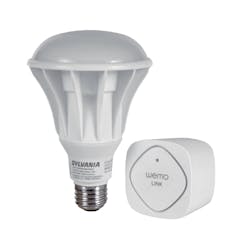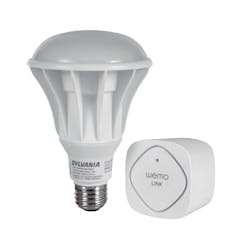Networking technology has become increasingly important in LED-based lighting, but the SSL sector is hampered by the lack of interoperable standards and the Consumer Electronics Show should see progress on that conundrum.
The Internet of Things (IoT) will be a major story at the Consumer Electronics Show (CES) 2016 slated for Jan. 6–9 in Las Vegas, NV, and one place that it appears that progress will be made is in interoperability of competing wireless standards. Such an outcome could prove very important in the smart solid-state lighting (SSL) world where there are perhaps even more networking options than in the general world of consumer electronics being pushed toward an IoT future. Indeed, the ZigBee and Thread groups have plans for interoperability and the EnOcean group also has a deal with the ZigBee side and other upstarts.
Interested in more news & announcements on LED control & networking standards?
First let’s define some of the players. The ZigBee Alliance is promulgating a wireless-mesh-based standard and has upper layer protocols for home and commercial applications. The standard has gained some momentum in the residential lighting space with the work of The Connected Lighting Alliance. ZigBee relies on the IEEE 802.15.4 standard for wireless mesh networks at the lower physical (PHY) and media access control (MAC) layers. Click here to view the LEDs Magazine issue that features a detailed article on network layers. [Note: The file size is greater than 13MB and you may experience a longer loading time.]
Osram Sylvania’s partnership with Belkin has yielded Lightify lamps that leverage the ZigBee wireless standard and are compatible with WeMo home automation.
There has been another set of proponents that have advocated the use of the 6LoWPAN (IPv6 over Low power Wireless Personal Area Network) network technology that ultimately provides an IPv6 (Internet Protocol version 6) address for every network node whether desktop computer or wireless-enabled LED lamp. And 6LoWPAN also relies on 802.15.4 at the PHY and Mac layers.
Open and interoperable
Over the course of last year, the Thread Group has arisen with the stated goal of creating a wireless network stack based on open standards — largely meaning that there would be no licenses that developers would have to pay to use the software stack. Thread is built on top of 802.15.4 and with 6LoWPAN service as a sub-layer between the Thread link layer and the 802.15.4 MAC layer. You can watch a technical overview from Thread in the video below. (Courtesy of the Thread Group)
At CES, the Thread Group and the ZigBee Alliance announced that protocols developed by ZigBee at the application layer will be able to run on the Thread network stack. That essentially means that the ZigBee Home Automation protocol, which includes lighting controls and other home-automation controls, could someday run on devices that support either the Thread or ZigBee network layers. The implementation is coming via the porting of a new ZigBee Applications Layer to Thread. That new ZigBee Applications Layer aggregates the market-specific ZigBee device profiles into one library of code.
“With this liaison agreement, we are bringing the industry’s most advanced and proven low-power networking layer experience to a complete and interoperable, end-to-end solution using our consolidated ZigBee Common Applications Library,” said Tobin Richardson, president and CEO of the ZigBee Alliance. “Building on more than a dozen years of experience in standards and ecosystem creation, we are now taking an important step toward IoT unification by adding compatibility with the Thread networking stack and its IP underpinnings to the ZigBee Alliance’s solutions portfolio. This portfolio spans all network layers and critical energy-harvesting and other foundational technologies, and is supported by all necessary interoperability and marketing solutions.”
In the CES announcement, the two organizations said each had completed technical evaluations of how to enable ZigBee protocols on an IP-based network. Moreover, the ZigBee Alliance said it was planning to deliver the new library along with an end-to-end certification program by the end of the third quarter of 2016.
“The ZigBee Alliance and Thread Group are taking a big step towards reducing IoT industry fragmentation,” said Chris Boross, president of the Thread Group and technical product marketing manager at Nest. “Bringing ZigBee’s application layer to Thread-enabled devices will simplify product development and increase interoperability, encouraging the Thread ecosystem — and the connected home — to flourish. Our organizations share many of the same members, and we look forward to collaborating with the ZigBee Alliance to offer the market a combined solution for the connected home.”
EnOcean and ZigBee
The collaboration between the ZigBee Alliance and the EnOcean Alliance, meanwhile, has been simmering for a couple of years. And last month the ZigBee group said it would adopt the technology promulgated by the EnOcean group for wireless communications in bands below 1 GHz. Essentially, the EnOcean Equipment Profiles (EEPs) and compliant products would be supported in the ZigBee 3.0 specification that is underway and meant to combine the disparate elements of ZigBee into a single standard.
What, you ask, is EnOcean’s play? The organization champions super-lightweight wireless protocols combined with sensors and actuators powered by energy harvesting rather than by batteries or the AC mains. For example, an EnOcean-compliant wireless switch can be powered by the act of a person depressing the switch. That kinetic energy is sufficient for a low-power microcontroller (MCU) to awaken and send a command to, say, a compliant lamp or luminaire. A light or occupancy sensor might operate based on harvested solar energy. We ran a feature article on the technology in mid-2015.
The EnOcean Alliance made an announcement headed into CES about its latest collaborations including with ZigBee. There will be EnOcean products in the ZigBee Alliance booth at CES interoperating with products based on the ZigBee wireless stack.
“Thanks to our cooperation with strong partners, we build the basis to directly connect battery-less sensor solutions to ZigBee 3.0 or the Internet and thus to open IoT platforms,” said Graham Martin, chairman of the EnOcean Alliance. “The user doesn’t need to care about the technology used by the single components but can benefit of a seamless connectivity in his smart home — the main concept of the IoT.”
Alas, there are still more dance partners in the IoT world. EnOcean will also collaborate with the AllSeen Alliance and the Open Interconnect Consortium. And those two organizations are seen as direct competitors. We covered that simmering feud based on CES exhibits last year. We’ll likely have more from these two organizations later this week.






